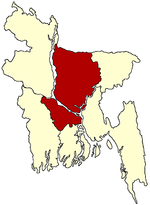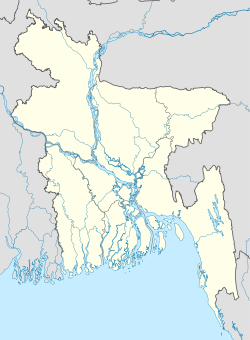- Munshiganj Sadar Upazila
-
Munshiganj Sadar
মুন্সিগঞ্জ সদর— Upazila — Location in Bangladesh Coordinates: 23°27.5′N 90°32.5′E / 23.4583°N 90.5417°ECoordinates: 23°27.5′N 90°32.5′E / 23.4583°N 90.5417°E Country  Bangladesh
BangladeshDivision Dhaka Division District Munshiganj District Area - Total 160.79 km2 (62.1 sq mi) Population (1991) - Total 294,823 - Density 1,834/km2 (4,750/sq mi) Time zone BST (UTC+6) Website Sadar.gif Official Map of Munshiganj Sadar Munshiganj Sadar (Bengali: মুন্সিগঞ্জ সদর) is an Upazila of Munshiganj District in the Division of Dhaka, Bangladesh.
Geography
Munshiganj Sadar is located at 23°27′30″N 90°32′30″E / 23.4583°N 90.5417°E . It has 50609 units of house hold and total area 160.79 km².Munshiganj (Town) consists of 9 wards and 42 mahallas.The area of the town is 14.17 km2. The population of the town is 52071; male 51.62% and female 48.38%; density of population is 3674 per km2. Literacy rate among the town people is 49.3%. The town has two dakbungalows. The old & famous high school name is Munshigonj Multiletaral High school.
Demographics
As of the 1991 Bangladesh census, Munshiganj district, formerly a subdivision under Dhaka district, was established in 1984. It consists of 6 upazilas, 67 union parishads, 662 mouzas, 906 villages, 18 wards, 73 mahallas and 2 municipalities. The upazilas are gazaria, tongibari, serajdikhan, lohajang, sreenagar and munshiganj sadar. Munshiganj is one of famous district in Bangladesh and it has great reputation.[1]
Administrative
Munshiganj Sadar has 12 Unions/Wards, 129 Mauzas/Mahallas, and 219 villages. There has a hospita named Munshigonj Sadar Hospital of 200 beds. There is a very famous and historic college named Haragonga College Munshiganj is also called as Bikrampur.
Archaeological heritage
Idrakpur Fort (1660) at Munshigonj town, Panditer Bhita (birth place of Atis Dipankar ) at Vajrayogini, Baba Adam’s Mosque at Rampal, home stead of Raja Vallala Sena, Rampal Dighi, Raja Harish Chandra’s Dighi, Kodal Dhoar Dighi, home stead of Raja Sreenath, marble statue of Ashutosh Ganguly at the library room of Haraganga College.
Historical events
During the Mughal rule the present Munshigonj town including the outlying areas was known as Idrakpur which was named after the then Mughal faujdar Idrak. A village on the outskirts of Munshigonj town is still known as Idrakpur. During the British rule Idrakpur was renamed as Munshigonj after the name of Munshi Enayet Ali, the local zamindar and the inhabitant of the village Kazi Kasba in Rampal.
In 1971
when the Pak army began mass-killing and massacre in Dhaka city on the night of 25 March the students and youths of Munshiganj raided the treasury and captured arms and ammunitions to resist the Pak army. They successfully guarded the river-side area to check the onrush of the Pak army towards Munshigonj. The people of Narayanganj in alliance with the youths of Munshiganj resisted an attack of the Pak army on 31 March. The Pak army first penetrated into Munshigonj on 9 May and killed some youths at Kewar on 14 May. The house of Radhika Mohan Ghosh at village Nayagaon on the bank of the Dhaleshwari had been the secret shelter and outpost of the freedom fighters. Attack on the ferries of the Pak army on the river used to be launched from the roof of this pucca building.
Marks of War
of Liberation Mass killing site and memorial monument 1 (old student hostel premises of Munshiganj High School).
Population
294823; Male 53%, Female 47%; Muslim 83.82%, Hindu15.78%, Buddhist 0.04%, Christian 0.05%, others 0.31%.
Religious institutions
Mosque 166, temple 22, mazar 2, dargah 1, akhra 1. Noted institutions: Kacharighat Jami Mosque, Thana Jami Mosque, Launch-ghat Jami Mosque, Jaikalimata Mandir, Jagaddhatri Mandir, tomb of Kadira Pagla, tomb of Chhala-pagli, dargah of Elahi Mastan, Lakshmi Narayan Jeu Akhra.Sarbojonin puja mandir of Bagmamudali para.
Literacy and educational institutions
Average literacy 35.5%; male 40.9%, female 30%. Educational institutions: college 4, high school 22, junior high school 4, primary teacher’s training institute 1, technical training centre 1, madrasa 9, government primary school 100, non-government primary school 9; noted old institutions: Government Haraganga College, Munshiganj High School.
Newspapers and periodicals
Weekly Munshiganj, Weekly Munshiganj Sangbad; defunct periodicals: Kaler Vela, Sangsaptak, Sarab.
Cultural organisations
Club 6, literary and cultural organisation 4, public library 2, musical academy 2, art school 1, theatre party 3, drama stage 1, cinema hall 6, auditorium 1, stadium 1.
Main occupations
Agriculture 25.64%, agricultural labourer 21.12%, fishing 1.32%, industry 1.1%, construction 1.52%, commerce 19.31%, service 9.34%, transport 3.1%, wage labourer 4.97% and others 12.58%.
Land use Cultivable
land 12140 hectares; single crop 6.5%, double crop 75.75%, and triple crop land 17.75%. Cultivable land under irrigation 36.2%.
Land control Among the peasants
27.8% are landless, 21.25% are marginal peasant, 32.95% small peasant, 13.5% intermediate, 4.5% rich; cultivable land per head 0.041 hectare.
Value of land
The market value of first grade arable land is Tk 70,000 per 0.01 hectare.
Main crops
Paddy, potato, wheat, jute, mustard, vegetables, chilli.
Extinct or nearly extinct
crops Indigo, kaun, linseed, arahar (pulse). Main fruits Banana, mango, papaya, jackfruit, litchi. Communication facilities Roads: pucca 27.27 km and mud road 100 km.
Traditional transport
Palanquin (extinct), bullock cart and horse carriage (nearly extinct), boat. Manufactories Large industry 2, medium industry 12, ice mill and cold storage 20. Cottage industries Various cottage industries and workshops 392.
Hats, bazars and fairs Hats and bazars are 17, fairs 8, most noted of which are Munshir Hat, Chitalia Hat, Mirkadim, Makahati, Munshiganj Bazar, Katakhali Bazar, Kamalaghat Bazar, Rikabi Bazar, Barani Mela (Kamalaghat), Rampal Maghi-purnima Mela, Dasami Mela (Kamalaghat), Munshiganj Rathjatra Mela, Rampal Rathjatra Mela, Manasa Mela (Munshiganj).
Main exports
Potato, patal, vegetables, jute.
NGO activities
Operationally important NGOs are asa, brac, proshika, Juba Sangha, Mahila Angana.
Health centres
Hospital 1, mother and childcare centre 1, upazila health complex 1, private clinic 4.
See also
References
- ^ "Population Census Wing, BBS.". Archived from the original on 2005-03-27. http://web.archive.org/web/20050327072826/http://www.bangladeshgov.org/mop/ndb/arpc91_v1/tables04.htm. Retrieved November 10, 2006.
 Upazilas of the Dhaka Division
Upazilas of the Dhaka DivisionCapital: Dhaka Dhaka District 
Faridpur District Gazipur District Gopalganj District Jamalpur District Kishoreganj District Astagram · Bajitpur · Bhairab · Hossainpur · Itna · Karimganj · Katiadi · Kishoreganj · Kuliarchar · Mithamain · Nikli · Pakundia · TarailMadaripur District Manikganj District Munshiganj District Mymensingh District Bhaluka · Dhobaura · Phulbari · Gaffargaon · Gauripur · Haluaghat · Ishwargan Mymensingh · Muktagachha · Nandail · Phulpur TrishalNarayanganj District Narsingdi District Netrokona District Atpara · Barhatta · Durgapur · Khaliajuri · Kalmakanda · Kendua · Madan · Mohanganj · Netrokona · PurbadhalaRajbari District Shariatpur District Sherpur District Tangail District Categories:- Upazilas of Munshiganj District
Wikimedia Foundation. 2010.

